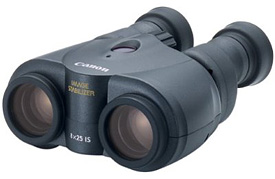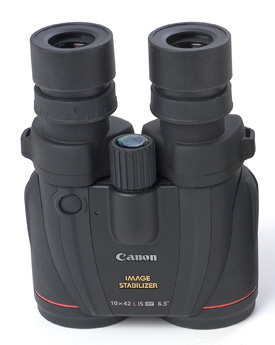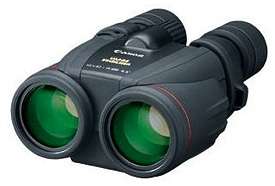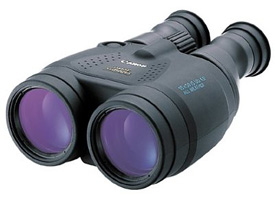
Over the years I’ve tested virtually every affordable image-stabilized binocular on the market for reviews appearing in Sky & Telescope magazine. Canon is the clear leader where astronomy is concerned.
The company offers several models, each with something to interest the backyard stargazer. Some of these binoculars are among the very best available for astronomy, while some are more general purpose. (Fujinon also makes 14×40 image-stabilized binos. You can read my thoughts on this model here.)
For a long time, standard 7×50 or 10×50 binoculars were considered the best choice for stargazing. Such binos are relatively lightweight, inexpensive, and capable of delivering fine wide-field views of the heavens. But most people find that hand-held 10×50s represents the upper limit of the weight and magnification comfort zone. Models featuring higher magnification or more aperture require a tripod or dedicated binocular mount for steady views. Even 10×50s rarely work near their potential without support. Unfortunately, such devices ensure that an instrument much loved for its portability and convenience becomes encumbered with as much paraphernalia as a small telescope. Enter the image-stabilized binocular.
Image-stabilized binoculars (ISBs) take the shakes out of the view with the push of a button and let you really see what the optics are delivering without a tripod or other support. The stabilization mechanism is powered by batteries and works through a combination of motion sensors and a what Canon calls a “vari-angle prism.” This optical and electronic wizardry effectively counteract the jiggles introduced by hand-holding binoculars. The effect never fails to startle and impress first-time users. That said, the very best views are usually had when you hold the binoculars reasonably steady to begin with. Using a chair is not only a more comfortable way to observe but also helps you get the most even out of image-stabilized binoculars.
The initial batch of Canon ISBs appeared more than 20 years ago and included 10×30, 12×36, and 15×45 models. The latter were replaced by 15×50s, which were introduced along with 18×50s in 2000. The most recent addition to the line up are the 10×42s and an updated version of the 12×36s. But which one is best?
Before we dig in, let’s get a few preliminaries out of the way. If you’re relatively new to binoculars and not sure what the various specifications mean, read my article, Binoculars By The Numbers, first. If the Adler Index cited below is new to you, you can learn about it in Rating Binoculars. Also, for detailed specifications and a breakdown of features, visit Canon’s web site.
Okay, let’s get started.

Canon 8×25 IS
Magnification: 8×
Aperture: 25mm
True field of view: 6.6°
Typical price: $250
Adler Index rating: 40
I’ve only had a little experience with this model, but enough to make some general comments about their suitability for astronomy. Short review: I’d spend the extra money to get the 10×30s reviewed below instead. A quick perusal of the above spec’s will make most of the reasons obvious.
In the hand, the 8×25s feel a bit cheap and plasticy compared with the other Canons. Further, this model is powered by a single CR123A battery. Given the power requirements of image-stabilized binoculars, this isn’t a good thing. The battery is relatively pricey and nowhere near as widely available as the AA’s used by the other ISBs. I also found the 52.8° apparent field of the eyepieces relatively cramped compared with the other binos in the line.
Summary: The least expensive and lightest of the Canon ISB line, but also the least useful for astronomy. Choose these only if money is really tight and you plan on using them more in daylight than at night.
Click here to check Amazon’s price. (Note: Using these links for purchases helps to keep this site up and running.)

Canon 10×30 IS
Magnification: 10×
Aperture: 30mm
True field of view: 6°
Typical price: $360
Adler Index rating: 55
Conventional wisdom might suggests that 30-millimeter objectives are too small for stargazing, but the 10× magnification, image stabilization, and superb optics more than make up for the smaller aperture. In fact, I found that the little Canons consistently outperformed my run-of-the-mill 7×50 Bushnell binocular when it came to showing deep-sky objects. What makes them all the more enticing is that in spite of their 10× magnification, they show a generous 6° of sky and weigh only 1.4 pounds (620 grams) — less than most 50-mm binoculars. Furthermore, if you plan on using your binocular for daytime viewing as well, remember that even without stabilization these will show as much as any 10× binocular — regardless of objective size.
The stabilization on the smallest Canon differs slightly from that on its larger siblings. There is about a 3-second delay between when the button is pushed and when the stabilization completely settles down. I have tested other 10×30s that didn’t have as great a delay, so perhaps it varies from unit to unit. Once the image settles down though, the jitters disappear as completely as in the larger and more expensive models. As with all the older models, you do have to hold the stabilization button down continuously.
I own a pair of these and find I use them more often than any other binocular in my collection. And I’m not alone in this. One of my Sky & Telescope colleagues, Tony Flanders, also uses his a great deal. Why? Because the 10×30s are versatile, lightweight, and compact — attributes that are desirable night and day. And mine have stood the test of time despite the abuses that frequent travel inflicts — they’ve taken a lickn’ and kept on tickin’. They’re also the best ISB choice for astronomers on a budget, costing only a little more than the less capable 8×25s, but around $200 less than the 12×36 model.
(Canon has recently introduced a version II of the 10×30s, which I review here.)
Summary: These are ideal all ’rounders — excellent for birding and very good for stargazing. Their price and features make them an appealing choice. However, if money and weight are not an issue, there are other options.
Click here to check Amazon’s price.


Canon 12×36 IS II
Magnification: 12×
Aperture: 36mm
True field of view: 5°
Typical price: $565
Adler Index rating: 72
The 12×36 ISBs can be thought of as the biggest of the small, lightweight Canon stabilized binos. On specifications alone, they have much to recommend them. Their magnification, field of view, and aperture, add up to a good stargazing instrument. Compared with the 10×30s, the 12×36s have a noticeable edge in resolution and in their ability to pull in fainter stars. This is good.
In terms of optical quality, the 12×36s have more in common with the 10×30s than their bigger siblings — which is to say they’re very good, but not quite as good as the best in the line. In particular, star images in the 12×36s start to degrade about ¾ the way to the edge of the field where they become mildly astigmatic (seagull shaped). This optical shortcoming certainly isn’t uncommon. Indeed, virtually all binoculars (including non-ISB models) break down to some extent at the edge of the field — and most do so far sooner and far worse than the 12×36s. What’s remarkable isn’t that the 12×36s suffer from this malady, it’s that the larger Canon ISBs don’t. For most daytime applications, this problem is likely to go entirely unnoticed.
Although there may be a sample-to-sample variation in play here, I found the image-stabilization in the 12×36 model a bit jumpy. The stabilization engages almost instantly and easily dampens out the tremors from hand holding, but does less well with larger-scale movement. However, the stabilization is essentially perfect when the binoculars are used while seated, which improves the performance of all ISBs to some extent.
The 12×36 I tested had wonderfully smooth and precise focusing, though birders will probably be less than thrilled by a closest-focus distance of 6 meters (20 feet). This is considerably farther than the 10×30s (4.2 meters) or the near-focus champs, the 10×42s (2.5 meters). Of course in the infinity-focus world of astronomy, this is a moot point.
On balance, the 12×36s are fine binoculars that will please most users. They’re pleasantly lightweight, have very nice optics that produce sharp, contrasty views, and are aided by a stabilization mechanism that works effectively (with the caveat noted above). But as satisfying as their performance is, for me the spec’s of 12×36 ISBs positions them between the stools somewhat. They lack the compactness and low price of the 10×30s, yet don’t pack the same visual punch as the bigger/higher-magnification Canons. That said, S&T Deep-Sky Wonders columnist Sue French gets a great deal of use out of hers — and that’s a pretty strong endorsement.
Summary: Very good binoculars that suffer only by comparison with other Canon ISBs. If you’re looking for something with more magnification than the 10×30s and less bulk and weight than the 15×50s, the 12×36s are, as Goldilocks might say, “just right.”
Click here to check Amazon’s price.

Canon 10×42 L IS WP
Magnification: 10×
Aperture: 42mm
True field of view: 6.5°
Typical price: $1,350
Adler Index rating: 65
Now we come to the real powerhouses of the ISB line, starting with Canon’s newest offering, the 10×42s. The optics of these binoculars are superb. Star images are point sharp and show only a minor amount of bloating at the very edge of the field. Views of the Moon are stunning and show a lunar surface crowded with sharp detail. Indeed, seeing the Moon’s brilliant disk floating in a dark, nearly ghost-free field was something I couldn’t resist returning to night after night with my review sample. Views of star clusters and rich Milky Way fields are simply breathtakingly wondrous. Under a dark sky, the 10×42s could keep a determined observer busy for years.
Much of the impact of these binoculars can be attributed to hitting a specification “sweet spot.” In general, 10× binoculars provide a near-ideal balance between magnification and field size — one usually wants the widest true field at the highest power for views with the best contrast and the most detail. The eyepieces feature a 65° apparent field, which translates into a 40 percent increase in true field compared with standard 10× binoculars.
Optics aside, the 10×42s felt great in my hands. They’re solidly built and feel as if they could take a lot of rough use — nothing was loose or rattled, and the rubberized exterior was comfortable to hold. And though most stargazers won’t fully exploit this feature, the “WP” in the name means “waterproof.”
Stabilization is activated by a single button push. Pushing the button again turns it off. One nice feature of these binoculars is what appears to be an orientation sensor that prevents the user from accidentally activating the stabilization when the binoculars are hanging from your neck and aimed at the ground. Once turned on though, the binoculars can be pointed straight down.
Given that Canon also makes similarly priced 15×50 and 18×50 stabilized binoculars (reviewed below), why go for the smaller 10×42s? I found several compelling reasons. First, both the 50-mm Canons have more restrictive fields of view: 4.5° for the 15× model and 3.7° for the 18×. That’s roughly ½ and ⅓ as much sky coverage, respectively. And not only are the 10×42s smaller; at 2.3 pounds, they weigh about ⅓ pound less than their bigger brothers. That might not sound like much, but it is a difference you can feel when holding them for extended periods. Also, birders will appreciate the close-focus distance of the 10×42s — a mere 8.2 feet, versus 19.7 feet for their 50-mm models.
Summary: Arguably, these are the ultimate astronomy binoculars. If you have the cash, buy ‘em. You won’t be disappointed.
Click here to check Amazon’s price.

Canon 15×45 IS
Magnification: 15×
Aperture: 45mm
True field of view: 4.5°
Typical price: N/A
Adler Index rating: 100
The Canon 15×45s were the first affordable image-stabilized binoculars available, and at the time were described as “revolutionary,” in a review by my S&T colleague, Dennis di Cicco. Although they’re no longer made, you might see them pop up on the used market from time to time. But aren’t used image-stabilized binos a gamble? Sure. But all used optical gear is a gamble. Definitely try before you buy. And though it’s only one data point, I can say that my 20-year-old 15×45s continue to work pretty much as well today as when they were new.
The performance of the 15×45s is excellent. The optics are sharp and crisp, the stabilization works well, and the 15× magnification gives significantly more detailed images than the 10× models. Indeed, most of what is true for the 15×50s reviewed below, is true for the 15×45s. These old binos have performed so well that I have never been tempted to replace them with a newer model — there just isn’t much to be gained.
Unlike the current models though, with the 15×45s you have to keep the stabilization button pressed continuously. Some people find that more of a nuisance than others — it doesn’t bother me at all since my index finger naturally lands right on the button. One little thing I do like about the 15×45s that it’s the only one with an indicator light that’s an astronomy-friendly, red LED, where others use an annoyingly bright green one. (This doesn’t bother the user, but others will see the light unless you cover it with your finger or put a piece of tape over it.)
Summary: If you can find them used, you might be able to get them at a bargain price. Just remember: try before you buy!

Canon 15×50 IS AW
Magnification: 15×
Aperture: 50mm
True field of view: 4.5°
Typical price: $950
Adler Index rating: 106
The 15×50s replaced the 15×45s and, unsurprisingly, offer the same excellent performance. Both 15× models produce a 4.5° field of view and pack enough magnification to resolve many open clusters and reveal a great deal of lunar detail. Simply put, the views are tremendous. And as their similar Adler Index ratings suggest, there’s little to choose between them Of course, the 15×50s are available new — and that’s likely to be the deciding factor if you think 15× binos are the best choice.
Many stargazers regard the 15×50 configuration as near ideal. Compared with the 10×42s and the 18×50s, the 15×50s are a relative bargain, which is possibly another reason why they’re among the most popular choices in the Canon line.
A few things make it to the minus side of the ledger though. First, these binoculars are a handful — they’re physically large and weigh in at 2.6 pounds. Second, I find the eyecups uncomfortable. They’re made from a very stiff rubber and really become annoying the longer you use them. Yes, they can be folded down, but then you lose the benefit of having them in the first place.
Summary: If you have the money and can live with the eyecups, there are your binos.
Click here to check Amazon’s price.

Canon 18×50 IS AW
Magnification: 18×
Aperture: 50mm
True field of view: 3.7°
Typical price: $1,100
Adler Index rating: 127
The most powerful of the Canon image-stabilized binoculars, the 18×50s are very much a mixed bag. They’re expensive, heavy (tied with the 15×50s for most weighty), have uncomfortable eye cups, and are a bit twitchy on the stabilization front. Of all the Canon binoculars, these are the most sensitive to changes in orientation. While they have no difficulty dealing with “shakes,” I found that it was necessary to hold the binocular reasonably still to take full advantage of its 18× magnification. Seated observing is virtually a must with these.
And yet, their higher magnification is an important strength. I found that the extra power did make a significant difference in what I could see, just as the Adler Index predicts. More fainter stars were visible than with the 15×50 model, and the magnification boost of the 18×50s also yielded the most detailed views of the Moon. However, for general stargazing the 3.7° field of view made locating targets a little more difficult than with lower-power models. The difference between 4.5° and 3.7° doesn’t sound like much, but it amounts to a 32% reduction in true-field area.
Summary: I wouldn’t recommend the 18×50s as your one and only binocular, but if you’re looking for a high-magnification model to compliment a 10× pair, these are a good option.
Click here to check Amazon’s price.
Gary’s Picks



You have to first decide if image-stabilized binoculars are a good fit for your budget and observing interests. You’re paying premium prices, and for the most part, you’re getting premium performance both optically and mechanically. But it’s worth noting that as good as the Canon stabilization system is (and it is very good), it isn’t perfect. At times, star images can become slightly comatic — stretching into tiny, comet-shaped blurs. This effect seemed to depend on how much work the stabilization mechanism is required to do and the binocular’s magnification (10× models are virtually unaffected). I found I could cheat the system by turning off the stabilization, recentering the target, and then turning the stabilization back on. This is a minor issue and scarcely detracts from the immense benefits of image stabilization — but it does exist.
Given the near-uniform quality of the Canon ISBs, your choice largely comes down to selecting the magnification, aperture, and price that works for you. If you’re on a budget and want a versatile binocular, the 10×30s are a good choice. But if you’re prepared to spend serious money, then I would look long and hard at the 10×42s and 15×50s — both are excellent in their own way.
The 10×42s are perhaps the best general-purpose astronomy binocular out there, but having said that, the 15×50s do show more detail. Really the choice comes down to what you think is more important: wide fields of view, or greater detail. And if maximum detail is your goal, the 18×50s are a good choice, though you do give up substantial field of view for that extra power.
Okay, enough fence sitting. Maybe. What would I choose? Readers of my book, already know the answer. If you took away all my binoculars and made me start over again with a single pair, I’d agonize a lot but ultimately I’d choose the 10×42s. They’re optically the nicest (by a whisker), the magnification allows the stabilization to work almost flawlessly, and the field of view is truly stunning. That said, on another day, I might choose the 15×50s — the extra magnification really does pay off. Tough call. But, if I could pick two, I’d go with the 10×30s for portability and wide field of view, and the 15×50s for serious observing. Okay, maybe that’s cheating, but you see how tough this can be!
And For the Birds?

Image-stabilized binoculars are (slowly) gaining popularity with birders, so which of the Canon’s is best if watching your avian friends is more important than stargazing? I do a fair amount of birding and find that two factors come in to play for this activity that don’t matter as much for astronomy.
First, because birding can involve a lot of hiking, light-weight binos are preferable. Second, close-focus distance can also be important. For these reasons, I usually go birding with my 10×30s Canons. They weigh only 22 oz (620g) and can focus on birds as close as 13.8 feet (4.2 meters). If birding were my only interest, I might also consider the 8×25s, which are even lighter (17.3 oz/490g), and are the close-focus king amongst the smaller ISBs, being able to focus to within 11.5 ft (3.5m). What about the 12×36s? They’re only a little heavier than the 10×30s (23.3 oz/660g), but the close-focus distance isn’t great: 19.7 ft (6 m). The extra magnification will bring in more detail though and could be the difference between a positive identification and a “maybe.” Keep in mind though that as the magnification increases, the field of view shrinks. If the field of view is too restrictive, acquiring your bird might be tricky. In the end, the kinds of birds you like to view and your birding style will likely tell you which of these is most suitable.
Did you find this article interesting or helpful? If so, consider using this link the next time you shop at Amazon.com. Better yet, bookmark it for future use. Thanks to Amazon’s associates program, doing so costs you nothing yet helps keep this site up and running. Thanks!
(Note: Some passages in this article originally appeared in Sky & Telescope magazine.)
